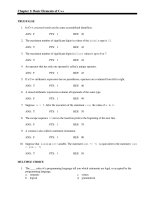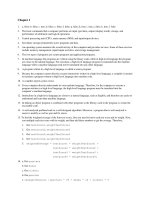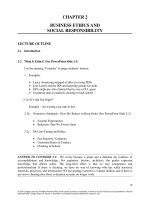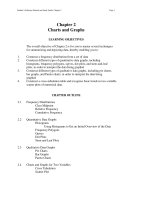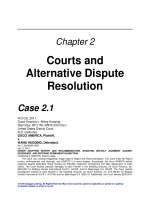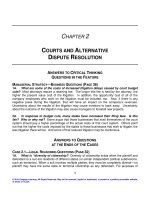Test band and solution of ch02 historical context and the futures (1)
Bạn đang xem bản rút gọn của tài liệu. Xem và tải ngay bản đầy đủ của tài liệu tại đây (622 KB, 10 trang )
CHAPTER 2
Historical Context and the Future of U.S. Global Power
LEARNING OBJECTIVES
1.
Describe the core concepts of isolationism, and determine whether or not U.S. foreign
policy has been isolationist.
2.
Identify the European and colonial roots of U.S. foreign policy.
3.
Explain how and why U.S. foreign policy—in national security and economics—evolved
as the United States became a global power in the twentieth century.
4.
Describe how the global environment and globalization affected American power from
the cold war through today.
SUMMARY OVERVIEW
This chapter frames modern foreign policy within its historical context, illustrating the evolution
of U.S. foreign policy and clearly identifiable trajectories of development from the era of
colonialism through the modern day. The context of foreign policy is broken into two parts. The
first provides a general history of U.S. foreign policy. In this section, the text addresses the
misperceptions or “myths” about American foreign policy historically such as the conflict
between the myth of early isolationism and the reality of internationalism. The skewed, mythical
history has been replaced with a reality of gradually increasing internationalism laid out in three
eras from the more comparatively contained “continental era” through the slightly more
international “regional era,” ending with the modern “global era”. The second part of the chapter
addresses how environmental context has impacted shifts in U.S. power and structured
corresponding patterns in policy. Focusing on three eras—early cold war, post Vietnam War and
post cold war—the text illustrate how a change in domestic consensus and relative power
internationally has shifted both how American policymakers approach events as well as the ease
in which policies can be carried out. The chapter concludes with a brief discussion overview of an
important debate: the future of U.S. primacy on the global stage.
CHAPTER OUTLINE
I.
II.
THE MYTH OF ISOLATIONISM
Overview of extensive U.S. military involvement
o
Prior to World War II: 163 armed interventions
o
Average of one per year
A.
European and English Colonial Roots
European competition—Role in creation of the United States
Colonialist dissatisfaction and push for independence
THE CONTINENTAL ERA
Copyright © Cengage Learning. All rights reserved.
8
Chapter 2: Historical Context and the Future of U.S. Global Power
A CLOSER LOOK Historiography and Competing Interpretations of
U.S. Foreign Relations
III.
THE REGIONAL ERA
IV.
Nation-building
o
Weak state surrounded by European colonial claims
o
Highly dependent on trade with England
Continental expansion goal
o
Land needed for security and economic growth
o
Means of Expansion
Purchase from weaker European powers
Predominantly inhabited by Native Americans
Northwest Ordinance of 1787
Expansion carried out by government officials (army)
Private citizens and entrepreneurs as agents of expansion
o
Leads to the development of an “imperial republic”
Activities beyond borders: sporadic
o
Commercial, political, military
Establishment of first diplomatic consulate (Canton,
China, 1989)
Latin America
Monroe Doctrine
Clayton-Bulwer Treaty
Efforts tended to be sporadic and not consistent
Made possible by the end of the Civil War
o
No more immediate threats in the Western Hemisphere
o
Consolidation of American imperial power and colonies
At home: Manifest Destiny
Abroad: Promotion of political stability and economic expansion
o
Latin America
Rapid expansion of trade
Promotion of friendly regimes
Olney Proclamation (1895)
Leads to carving out an American “Sphere of influence”
o
Expansion of trade ties with China
o
Increased involvement in European Affairs
World War I, Treaty of Versailles, League of Nations
o
End of World War I would lead to “height of isolationism” in the 1920s
and 1930s.
Evidence for
Rejection of League of Nations
Growing public isolationist sentiment
Reluctance to be involved in European affairs
Evidence against supposed isolationism
Continued involvement in Latin America
Role of America in global economy
“Formal” and “Informal” empire: Inconsistent
THE GLOBAL ERA
A.
World War II and Immediate Postwar Foreign Policy
Copyright © Cengage Learning. All rights reserved.
Chapter 2: Historical Context and the Future of U.S. Global Power
B.
C.
The Cold War Era
2.
VI.
VII.
Challenges to policy
o
Military: Failure of containment policy in Vietnam
o
Economic: Breakdown of Bretton Woods
Two images of American policy: Virtue and arrogance
Three patterns foreign policy emerge
o
Containment loses policy monopoly.
o
Foreign economic policy gains emphasis.
o
Loss of policy consistency
The Post-Cold War/Globalization Era
1.
V.
Era of considerable continuity based on two goals
o
Goals: national security (high policy) by containment and
deterrence; Truman Doctrine
Fear of Soviet communism key problem for
most Americans
o
Goals: economic prosperity (low policy) by liberal economic
order; Bretton Woods II
“Hearts and minds” strategy
Focus on free trade and fixed exchange rates
The Post-Vietnam War Era
D.
Restore stability and prosperity—Bretton Woods system
Construct new international political order—United Nations
Changes: Reactive rather than proactive
o
Loss of communist threat
o
Economic changes
o
Fickle domestic support
THE GEORGE H. W. BUSH ADMINISTRATION.
No dominant foreign policy pattern; pragmatism
THE CLINTON ADMINISTRATION.
Reactive rather than proactive foreign policy
THE GEORGE W. BUSH ADMINISTRATION AND SEPTEMBER 11
Post September 11, 2001
Changes: Bush Doctrine and war on terrorism
o
Deterrence, containment, preemption
o
Build-up of defense
o
Unilateralism
o
Spread of liberalism, democracy
THE LIBERTY-SECURITY DILEMMA
Pendulum Effect
War, Peace, and the
THE BARACK OBAMA ADMINISTRATION AND THE GREAT RECESSION
Effects of global recession
Emphasis on multilateral policy responses
“Arab Spring”
GLOBALIZATION, AMERICAN POWER, AND THE TWENTY-FIRST CENTURY
The global environment as context for policy
Copyright © Cengage Learning. All rights reserved.
9
10
Chapter 2: Historical Context and the Future of U.S. Global Power
o
o
o
Underlying: Parameters for policy
Immediate: Crises
How the context shapes policy
Psychological environment—Perceptions
Objective environment
Three stages of the global environment and American power:
o
Cold War: American Hegemony (1940s-1960s)
Bipolar global conflict between U.S. and U.S.S.R.
U.S. as a global economic leader
Rise of interventionism
A.
The Global Cold War and American Hegemony
o
B.
C.
Global Complexity and American Decline
VIII.
Pluralism and interdependence
o
Relative Decline in power
Relative economic decline
Inability to use force to promote interests
o
Vietnam War symptomatic of increased resistance to U.S. power
Soviet Collapse, September 11th, and American Renewal
After WWI and WWII, America and the Soviet Union became key
players in global affairs.
American-Soviet conflict became inevitable
Free world vs. a totalitarian world
America as “World’s policeman” and “World’s banker”
Collapse of communism, rise of globalization
o
End of Cold War Rivalry
o
Rise of globalization
Free trade increases (NAFTA, WTO)
Boom and bust of global systems
Continuation of global conflicts
o
Terrorism
o
Traditional disputes/rivalries
o
Various sources of global conflict
A DIFFERENT PERSPECTIVE
Competing Global Theories
IS THE TWENTY-FIRST CENTURY THE AMERICAN CENTURY?
America: Decline or revival?
o
Declinists:
Growth and decline cycles
Imperial overstretch
o
Revivalists:
Self-renewing genius
Exaggerated claims of decline
No true rival
Soft-power vs. hard power
A.
The Challenge of Hegemony and Legitimacy
Hegemony and legitimacy
o
Reactions to hegemonic states
Align with the power (bandwagon, bond, penetrate)
Copyright © Cengage Learning. All rights reserved.
Chapter 2: Historical Context and the Future of U.S. Global Power
11
Reign in the power (balancing, balking, binding,
blackmail)
Delegitimize the power
How others view United States primacy
How the United States views itself
CRITICAL THINKING QUESTIONS
1.
Why does the myth of isolationism exist? What other myths surround U.S.
foreign policy?
2.
Should the United States become more isolationist today or should it increase its
involvement in global affairs?
3.
Which interpretation (or combination of interpretations) best explains the historical
patterns of U.S. foreign policy: Orthodox, revisionism, or post-revisionism?
LECTURE LAUNCHERS
1.
What does it mean to be isolationist? Does it require a state to have no interactions with
the rest of the world?
2.
Debate: Is the United States likely to be more or less isolationist in the near future? In
what aspects do you think the U.S. should be more or less involved in global affairs?
IN-CLASS ACTIVITIES
1.
Divide the class into three groups: Classical realists, liberal internationalists, and social
globalists. Have each group develop a comprehensive foreign policy based on their
perspective of international relations to the following scenario:
Following a popular revolution, the monarchy in Widgetstan is replaced by a
populist government that is hostile to the United States. Widgetstan has been the
major supplier to the United States of widgets, which are vital to the American
economy and military might. Although there are a few other providers of widgets
in the world, no other sources can replace the widget supply from Widgetstan.
The new government is led by people who feel that the monarchy was a puppet
of the United States and sold widgets to the United States for its own gain, while
the population of Widgetstan lived in poverty. Develop a comprehensive foreign
policy towards Widgetstan that your group best thinks will secure a supply
of widgets.
2.
Have the class debate the merits of the United States ceasing participation in major
international institutions. Some examples: The United Nations, the World Bank,
International Monetary Fund, and the North Atlantic Treaty Organization.
KEY CONCEPTS
bipolarity A situation where two states in the international system control the majority of
economic and military resources. The Cold War world was a bipolar world because of the
dominance of the United States and U.S.S.R.
Copyright © Cengage Learning. All rights reserved.
12
Chapter 2: Historical Context and the Future of U.S. Global Power
cold war A state of political tension where states engage in military and economic rivalry
without engaging in direct and full-scale war. Commonly this term is used to describe the
relationship between the United States and U.S.S.R. from about 1945 to 1990.
conservative realism A theory of international relations that tends to see the world as relatively
anarchical and conflictual in which the primary actors are (sovereign and independent)
states, the most important issues revolve around national security and the use of force,
and the principle motivation is the promotion of national power and wealth and prestige.
So-called “realists” focus on the tremendous uneven distribution of power among states,
on great power conflicts (and alliances and empires), the rise and decline of power, the
maintenance of stability and order, and the utility of force as a means to settle disputes
and international conflict. Conservative realists tend to be more pessimistic about the
future possibilities of a world of greater peace, prosperity, and human development.
containment strategy Initially embodied in the Truman Doctrine, announced in 1947 and
directed at containing Soviet expansion through military, diplomatic, and
economic means.
declinists A school of thought that is pessimistic over the future of American power in the global
system. Declinists tend to argue decline occurs if the gap widens between a great power’s
ends and means—between its foreign policy goals and its ability to carry them out. In
their mind, the United States is getting weaker in the world.
empire A term used to describe the areas of the world controlled by a central government
including the boundaries of the state and any additional territory under its control.
global context- or setting, environment, or milieu Refers to phenomena beyond or external to
the institutions, beliefs, and processes of human interaction in government and society.
globalization The process of creating a single, integrated international political economy of
growing interdependence and complexity.
hegemonic power A state that is able to control world events through its implied military,
economic, and cultural power.
high policy Terms used to distinguish the differing levels of importance between national
security concerns (high-policy) and economic policy concerns (low-policy) that allowed
national security concerns to dominate American foreign policy during the cold war.
imperial overstretch A condition when a great power finds its military, economic, and political
capacity to protect its global interests and agendas begins to decline usually through
over commitments.
imperial republic A description of the American experience of internal colonialism on the North
American continent. Although the United States was a republican government, it had
many imperial subjects (Native Americans and other colonial subjects).
international crises (Commonly defined in terms of surprise, a threat to values, and little time to
respond) are events that catapult an issue on the political agenda and often play an
influential role in the politics of U.S. foreign policy.
isolationism A foreign policy that features uninvolvement in world affairs.
Copyright © Cengage Learning. All rights reserved.
Chapter 2: Historical Context and the Future of U.S. Global Power
13
liberal idealism A perspective of international relations that sees the world as defined by
cooperation and interdependence. States are important international actors, but the
dominance of states has diminished with the advent of other influential actors, such as
international organizations, multinational corporations, ethnic groups, and so on. Liberal
idealists tend to be much more optimistic about the potential for greater cooperation and
peace, prosperity, and human development throughout the world. In their view, the state
is not a hypothetical single, rational, national actor in a state of war (as it is in the realist
ideal), but a coalition or conglomerate of coalitions and interests, representing individuals
and groups and transnational actors.
low policy Terms used to distinguish the differing levels of importance between national security
concerns (high-policy) and economic policy concerns (low-policy) that allowed national
security concerns to dominate American foreign policy during the cold war.
manifest destiny Founded on the a priori conviction of the uniqueness of the American nation
and the necessity of an American empire.
nation-building The building of an independent country safe from its neighbors through
constructing a strong national economy and establishing a stable democracy.
origins of the cold war Though there are several interpretations, in the 1950’s, many believed
that the cold war began due to Soviet-communist expansionism.
orthodox interpretation An interpretation of the history of U.S. foreign policy. This view tends
to depict the United States as isolationist prior to such events as the Spanish-American
War and World War I and then not isolationist following these events despite evidence of
heavy U.S. involvement during the isolationist periods.
paradox of American power A description of the contradiction that even though the United
States continued to be the most powerful country in the world but no longer was as able
to exercise the kind of economic, political, and military influence that it enjoyed at its
height during the late 1940s and 1950s.
postrevisionism An interpretation of the history of U.S. foreign policy. According to this view,
although U.S. foreign policy was never isolationist, it did experience both continuity and
change over time. On the one hand, the United States steadily grew in power and
expanded throughout North America and the world over 200 years. On the other hand,
the United States experienced changes in its foreign policy; most important, the scope of
its involvement abroad grew over time.
psychological versus objective environment Explained by Harold and Margaret Sprout (1965)
in The Ecological Perspective on Human Affair: “So far as we can determine,
environmental factors (both nonhuman and social) can affect human activities in only two
ways: such factors can be perceived, reacted to, and taken into account by the human
individual or individuals under consideration. In this way, and in this way only …
environmental factors can be said to ‘influence,’ or to ‘condition,’ or otherwise to ‘affect’
human values and preferences, moods, and attitudes, choices and decision.” In contrast,
environmental factors limit the execution of human undertakings. “Such limitations on
performance, accomplishment, outcome, or operational result,” the Sprouts assert, “may
not—often do not—derive from or depend upon the individual’s perception or other
psychological behavior.”
Copyright © Cengage Learning. All rights reserved.
14
Chapter 2: Historical Context and the Future of U.S. Global Power
revisionism An interpretation of the history of U.S. foreign policy. Revisionists rejected the
isolationist thesis and tended to depict the history of U.S. foreign policy as being much
more “continuous” and globally expansive since its beginnings.
revivalists Those who argue the United States will increase its power in the global system. From
this perspective, a decline in relative American power may actually translate into an
overall increase in America’s position in the world community if the nation’s economy is
strengthened because of inherent leadership advantages the U.S. possesses.
social globalism A perspective of international relations that tends to see the existence of a
global system as one in which power and wealth is incredibly unevenly distributed
throughout the world.
sphere of influence An area over which a state is able to wield political, economic, and military
control over.
WEB LINKS
Articles debating if U.S. leadership is in decline:
Victor Davis Hanson. “American in Decline?” Hoover International Journal, June 16, 2011.
( />Robert D. Kaplan.“ U. S. Hegemony May Be in Decline, but Only to a Degree,” The Washington
Post, December 17, 2008. ( />Articles about the legitimacy of U.S. leadership
Kevin Slaten, The Decline of U. S. Hegemony: Regaining International Consent as a Result of
Loss of Legitimacy. The Journal of Politics & International Affairs, Winter 2009.
( />Adam Clayton Powell III, “U. S. Leadership Still Viewed Positively, but With Major Declines in
Africa,” Newswire, University of Southern California on Public Diplomacy at Annenberg School,
April 19, 2012.
( />ositively_but_with_major_declines_in_africa/).
INSTRUCTOR RESOURCES
Alstyne, Richard W. Van. The Rising American Empire. New York: W.W. Norton, 1974. Print.
A classic realist revisionist account of the history of U.S. foreign policy.
Cox, Michael. (2002) “September 11th and U.S. Hegemony—Or Will the 21st Century Be
American Too?” International Studies Perspectives 3: 53–70. Print.
Excellent overview of the long-running debate about the rise, decline, and revival of
American power.
Hendrickson, David C. (2004) “A Dissenter’s Guide to Foreign Policy.” World Policy Journal
(Spring): 102–13. Print.
Excellent book review essay on competing interpretations of the future of
Copyright © Cengage Learning. All rights reserved.
Chapter 2: Historical Context and the Future of U.S. Global Power
15
American power.
Judt, Tony. (2004) “Dreams of Empire,” New York Review of Books (November 4). Print.
Excellent book review essay on competing interpretations of the future of
American power.
Kennedy, Paul. The Rise and Fall of the Great Powers: Economic Change and Military Conflict
from 1500 to 2000. New York: Random House, 1987. Print.
The classic statement on the rise and decline of American power in world affairs.
Kuttner, Robert. The End of Laissez-Faire: National Purpose and the Global Economy After the
Cold War. New York: Knopf, 1991. Print.
Excellent overview of the international political economy since World War II and the
role of the United States within it.
LaFeber, Walter. The American Age: U.S. Foreign Policy at Home and Abroad Since 1750. New
York: W.W. Norton, 1994. Print.
Good overview of the history of U.S. foreign policy.
----------. America, Russia, and the Cold War, 1948–2006.New York: McGraw-Hill, 2006. Print.
Informative history of U.S. foreign policy since World War II.
Lizza, Ryan. (2011) “The Consequentialist: How the Arab Spring remade Obama’s foreign
policy.” The New Yorker (May 2). Print.
Excellent overview on Obama’s initial education as a liberal internationalist, and his
evolution as a practitioner to be increasingly pragmatic and realist.
Melanson, Richard A. Writing History and Making Policy: The Cold War, Vietnam, and
Revisionism. Lanham, MD: UP of America, 1983. Print.
In-depth summary of competing interpretations of the origins of the cold war.
Nobles, Gregory. American Frontiers: Cultural Encounters and Continental Conquest. New
York: Hill and Wan, 1997. Print.
Excellent overview of American continental expansion.
Nye, Joseph S., Jr. The Paradox of American Power: Why the World’s Only Superpower Can’t
Go It Alone. Oxford UP, 2003. Print.
A synthesis of Nye’s works, hard and soft power, and America’s future role in the world.
Perkins, Dexter. The American Approach to Foreign Policy. New York: Scribner, 1968. Print.
A classic orthodox interpretation of the history of U.S. foreign policy.
Ryan, Alan. (2008) “What Happened to the American Empire?”New York Review of Books
(October 23). Print.
Excellent book review essay on competing interpretations of the future of
American power.
U.S., White House. (2002) The National Security Strategy of the United States of America.
September, Washington, D.C. Print.
The official national security strategy of the Bush administration after September 11.
Copyright © Cengage Learning. All rights reserved.
16
Chapter 2: Historical Context and the Future of U.S. Global Power
Walker, J. Samuel. (1981) “Historians and Cold War Origins: The New Consensus,” in Gerald K.
Haines and J. Samuel Walker, eds., American Foreign Relations: A Historiographical Review.
Westport, Conn.: Greenwood Press, 1981, pp. 207–36. Print.
Excellent and succinct overview of competing interpretations of the cold war.
Walt, Stephen. Taming American Power: The Global Response to U.S. Primacy. New York:
W.W. Norton, 2005. Print.
An excellent discussion of the kinds of responses other countries are likely to take to
address American hegemony.
Copyright © Cengage Learning. All rights reserved.

